©First published November 2015 – Updated October 2024
Your opinion counts . Starting next year we will start Calling our readers, a space so that you can write your comments on SGK-Planet on our usual topics, such as this Brief history of the COPs , and thus be able to join the fight against climate change. In addition, our readers will be able to benefit from your comments and opinions. (See rules and conditions at the end of this report).
From COP1 to COP28 – With Preliminaries to COP29
The Brief History of the COPs, Conference of the Parties, is a report in brief chronology format, as its name indicates, on what has happened at the most important climate conferences.
The Brief History of COPs and The Brief History of the COP , are original creations of SGK-PLANET, written by Sandor Alejandro Gerendas-Kiss, first published in November 2015. We make this clarification due to the imitations that have arisen trying to confuse the public.
The Brief History is updated twice a year to provide our readers with accurate, recent, summarized and useful information, so they can quickly find out how the Earth is doing, and the role that the COPs have played in the important issues that affect all of us who travel in this friendly blue spherical hotel with three different movements.
This edition covers COP1 (1995) through COP28 (Nov-Dec 2023), plus a short preview of COP29 (Nov-2024). We are very honored that you are reading this right now, and we hope you find it useful and can share this “Brief History” with your family and friends.
What are the COPs and what are their objectives?
The COP or Conference of the Parties, which are the states and the European Union, was created with the premise of strengthening public awareness on a global scale on the problems related to Climate Change. The COP are annual meetings originating from the United Nations Framework Convention on Climate Change (UNFCCC), a treaty approved at the Earth Summit, Rio de Janeiro, 1992 or Rio 92 Summit , which establishes the basic obligations of the parties to combat climate change, such as the stabilization of greenhouse gas concentrations in the atmosphere, in order to prevent risks to the Earth’s climate system.
Who participates in the COP?
The annual meetings are attended by environmental experts, ministers, heads of state, non-governmental organisations and, in some meetings, civil society and the private sector. In recent years, emphasis has been placed on youth participation, creating spaces and events for them.
Why are COPs annual?
between the first and second World Summits (Stockholm 1972 and Rio 1992). Given the rapid advance of global warming and climate change, it was thought that annual conferences should be held to make more effective progress in the fight against climate change.
COP Conferences, a long history of disagreements and postponements
While it is true that in a quarter of a century the world has improved its vision on issues such as global warming, climate change, wind energy, solar energy, green hydrogen, green cities and electric cars, there is still much to be done.
When you read this Brief History, you will be able to make a list of good intentions, ideas, promises, protocols and agreements at the COPs, but most of which have fallen by the wayside. You will see that, in many crucial meetings, where everything seemed to be going in the right direction, on the last night what had been patiently built up by hand for two weeks is demolished. Note that the phrase that has been repeated most often over the years is “it is postponed to next year.” Below we will go with the summaries of the different COPs that have been held so far.
1995 COP1, Berlin: the first COP Conference is born
This gave rise to the Berlin Mandate, a kind of rather vague catalogue of commitments that allowed countries to choose initiatives that best suited their particular needs.
1996 COP2, Geneva: consensus to set binding targets
The need to set “binding quantitative objectives” for limiting greenhouse gas emissions by industrialized countries, with precise reductions for 2005, 2010 and 2020, was adopted by consensus. Finally, it was agreed to address this matter the following year in Kyoto, Japan.
1997 COP3, Kyoto: the Kyoto Protocol is born with a built-in death date
COP3 was held in the Japanese city and after intense negotiations the famous Kyoto Protocol was adopted. Until then, together with the 1987 Montreal Protocol for the protection of the ozone layer, it was seen as one of the two most important and hopeful documents for humanity to regulate anthropogenic activities, capable of recovering the global environment. In Kyoto, binding objectives for GHG emissions were established for 37 industrialized countries.
However, two of the largest emitters, the United States and China, did not ratify the document. The Kyoto Protocol was agreed to enter into force eleven years later, in 2008, and its expiry date was pre-set for 2012, establishing that developed countries should reduce their GHG emissions by 5% in relation to the 1990 level in those five years.
1998 – 2006: Nine COPs with little progress to report
Nine conferences were held between these dates:
1998 COP4 , Buenos Aires / 1999 COP5 , Bonn / 2000 COP6 , The Hague and (2nd part), Bonn / 2001 COP7 , Marrakech / 2002 COP8 , New Delhi. / 2003 COP9 , Milan. / 2004 COP10 , Buenos Aires. / 2005 COP11 , Montreal / 2006 COP12 , Nairobi. Nine years were almost wasted, spent mainly on finalising the details of the Kyoto Protocol, with a view to its adoption in 2009, but which finally ended its days before it was born.
2007 COP13, Bali: The road to replacing the Kyoto Protocol
The Indonesian conference marked a significant step towards replacing the Kyoto Protocol, even though it has not yet been activated. It was also concluded that the signs of global warming are undeniable and the “Bali Action Plan” was finally adopted, which sets the framework for the negotiations that would lead to COP 15 in Copenhagen two years later.
2008 COP14, Poznan: looking towards Copenhagen
The Polish city welcomed the programme for the transfer of sound ecological technologies to developing countries and finalised the details for the important event next year.
2009 COP15, Copenhagen: Humanity’s great hope ends in great disappointment
The long-awaited COP15 meeting, which was highly anticipated, finally took place. It was thought that the Danish capital would have the privilege of giving the world the good news by announcing a new protocol for reducing greenhouse gas emissions: “the conclusion of a legally binding agreement on climate, valid for the whole world, to be applied from 2012”, as stated in its central objective.
This, in quantifiable terms, meant a reduction in CO2 emissions to less than 50% by 2050 compared to 1990. But the euphoria did not last long. Three weeks before the start of COP15, a meeting was held in Thailand, at which China and the United States decided that the Copenhagen agreements would not be binding. Thus, the fate of the Summit was sealed before it began. It was bad news and the few hopes of saving it were buried on the last night, when the presidents of China, the United States, India, Brazil and South Africa, without the presence of European representatives or other countries, held a meeting behind closed doors and in just three pages they drafted a non-binding agreement that was not even put to a vote.
In the end, it was only made public for the attendees to “gain knowledge” and the promise that a political platform would be developed in early 2010, the basis for legally binding commitments at COP16. The summit, as expected, was described as a failure and a disaster by many governments and environmental organisations. Herman Van Rumpuy , President of the European Council, in a confidential cable from US diplomacy, leaked by WikiLeaks, dated 4 January 2010, had very harsh words: “Copenhagen was an incredible disaster (…) multilateral summits will not work”, and he described the meeting as “Nightmare on Elm Street II” and uttered the lapidary phrase: “Who wants to see this horror film again?”
2010 COP16, Cancun: creation of the Green Climate Fund
Among the main agreements reached in Mexico, the creation of the Green Climate Fund stands out, which establishes a sum of one hundred billion dollars each year starting in 2020, and thirty billion dollars for the period 2010-2012, in order to help countries with fewer resources to cover the costs involved in the fight against Climate Change. The final document establishes the adoption “as soon as possible” of a decision on commitments for a second phase of the Kyoto Protocol to guarantee “that there is no gap between the first and second commitment periods.”
2011 COP17, Durban: the birth of the Kyoto Protocol II and the beginning of its demise
The fate of the planet was no better in Durban, South Africa, than in previous years. However, some progress was made by setting a date for the start of the second period of the Kyoto agreements, with a view to 2013. This presumed a legal vacuum on climate change. The summit concluded with a roadmap for a global treaty, as demanded by the European Union, which would commit the big polluters, those who did not sign the Kyoto Protocol, such as China, the United States, India, Brazil and South Africa, to comply with the treaty. The bad news was that Canada announced its intention not to renew Kyoto, seconded by Japan and Russia. This bucket of cold water ended all hopes for the Kyoto Protocol II.
2012 COP18, Doha: Kyoto is extended, but it is now impossible to revive it
For some time now, it has been expected that there would be no major surprises in Qatar, as its objectives did not seem complicated, but in practice the road was strewn with obstacles. The 194 countries gathered together reached a minimal agreement, the “Doha Climate Gate”, which extended the Kyoto Protocol until 2020. Negotiations on larger donations by developing countries were postponed until the following year. Most delegations expressed their dissatisfaction because the final agreement did not comply with scientific recommendations, which called for vigorous action to counter global warming. Carbon dioxide emissions in 2012 were already double the rate of 1990.
2013 COP19, Warsaw: mass abandonment of the summit
The initial aim in Poland was to reach an agreement to reduce emissions of polluting gases by 2015. However, this agreement was opposed by several countries, including the host country, which has a coal-based industry. A roadmap towards a global and binding pact was finally agreed in 2015, but many loopholes remained open, which had to be resolved at the Lima summit the following year.
A notable fact was that, one day before the summit was due to close, there was a massive walkout by NGOs and trade unions, an unprecedented event at the COP. The main NGOs criticised “the retrograde positions of Japan and Australia, as well as the lack of commitment of the most developed countries, which turn a deaf ear to the pressing needs of the poorest and most vulnerable to climate change.” They denounced that “the European Union remains tied to the positions of Poland and the coal industry,” impeding the process of combating climate change.
2014 COP20, Lima: great expectations and preparations for Paris 2015
In the Peruvian capital, the most important event was that the United States and China announced a joint commitment to reduce greenhouse gas emissions for the first time in history, which is essential to prevent global temperatures from exceeding 2ºC (later corrected to 1.5ºC, on the recommendation of scientists from the IPCC, the Intergovernmental Panel on Climate Change). The UN considered that the objective was to reduce emissions by 40% to 70% by 2050, and to 0% by the end of the century. The agreement, finally ratified, was an agreement that brought positions closer together in view of Paris 2015.
2015 COP21, Paris: the Paris Agreement is born
The Paris Agreement is an ambitious global convention to combat climate change, negotiated within the framework of COP21. It was adopted by 197 countries in Paris on December 15, 2015, and its signing officially began on April 22, 2016, Earth Day. Its implementation is set to begin in 2020. The Paris Agreement provides for limiting global temperatures to 2ºC (later corrected to 1.5ºC) by reducing GHG emissions caused by fossil fuels such as oil, gas and coal, which cause the greenhouse effect and consequently climate change, such as rising sea levels, floods, landslides, hurricanes, tornadoes, forest fires and other catastrophic phenomena, capable of endangering many species that inhabit the Earth, including Homo sapiens.
It is fair to acknowledge that the Paris Agreement, with its goals of reducing temperature and greenhouse gas emissions, is an inductor of countries, cities, industries, universities and people. With it, significant growth is being achieved in the production of cars and transport systems powered by clean fuels, such as green hydrogen, accelerated manufacturing of photovoltaic solar panels and a large number of wind generators, to supply clean electricity to millions of people around the world.
See related article: The Paris Agreement, the hope of humankind
2016 COP22, Marrakech: a technical meeting
The 22nd edition of the COP took place in the Moroccan capital, characterized by its low profile and scant media coverage, which is why some have called it a “technical meeting.” At this meeting, a working paper was adopted to implement the Paris Agreement and a roadmap was approved that would lead to the rules that will guide the essential agreement. COP24, Poland 2018, was set for its conclusion and start of its implementation, a kind of bridge to 2020, when the implementation of the Paris Agreement will begin.
2017 COP23, Fiji-Bonn: first COP with two host countries
The 23rd Conference of the Parties on Climate Change took place in Bonn from 6 to 17 November 2017. The German city provided the venue, infrastructure and part of the organisation required for the event. Fiji is a tiny island country in the Polynesian Islands, whose low altitude makes it very vulnerable to the foreseeable effects of climate change. Its Prime Minister, Frank Bainimarama, assumed the presidency of COP23 determined to maintain the momentum of the Paris Agreement. It is noteworthy that Bainimarama was very active and enthusiastic during and after COP23.
The United States attended the conference with a low-ranking delegation, following President Donald Trump’s decision to withdraw from the Paris Agreement. The speech by China’s representative showed a more active role compared to previous conferences.
Everything went smoothly until the last night when the meeting was suspended, which lasted until the early hours of the morning. Miguel Arias Cañete, European Commissioner for Climate Action, told EFE: “Nations that have not raised objections throughout the process leading up to this climate summit, or during it, are raising them now in the hope of achieving results for their countries.”
2018 COP24, Katowice: Controversy over IPCC report
COP24 was held in Katowice, Poland, from 3 to 14 December 2018, under the motto “Let’s change together”. This was the third time that Poland would host these important conferences. The 24th Conference of the Parties was one of the most secretive and least newsworthy meetings we have ever seen. Perhaps the chosen location and date contributed to the scant media coverage and low public interest in the event, which only picked up, and only partially, after the summit was over.
The controversy in Katowice this time was not about the Paris Agreement, but about the document of the IPCC, a group of scientists from the Intergovernmental Panel on Climate Change, which was presented in October of that year. In its “Fifth Assessment Report”, the main objective of which is to limit the rise in temperatures to 1.5 degrees Celsius from their pre-industrial level. This goal, according to the report, “will require unprecedented changes” at a social and global level, due to the seriousness of the situation on the planet, due to the sustained increase in global temperature, and all its foreseeable consequences.
An oil quartet consisting of the United States, Russia, Saudi Arabia and Kuwait did not welcome the report. The United States argued that welcoming it meant accepting it. President Trump said he did not agree with the IPCC report, nor did he believe in its content. The representative of Saudi Arabia went so far as to say behind the scenes that “the Paris Agreement is dead.”
WWF Spain summed up what happened like this: “World leaders came to Katowice tasked with responding to the latest climate science, which has made it abundantly clear that we only have 12 years to halve emissions and avoid catastrophic global warming. Progress has been made, but what we have seen in Poland reveals a fundamental lack of understanding of the current climate urgency by some countries . The future of all is at stake. We need all countries to commit to increasing climate ambition before 2020.”
2019 COP25, Chile-Madrid: Spain saves the conference
COP25 began in an unprecedented way, as Chile, the host and organiser of the conference throughout the year, had to cancel it at the last minute, due to the political instability that had been occurring in the country since October. When everything indicated that it would be impossible to meet the scheduled date, Madrid managed to organise the conference in record time, thanks to the timely intervention of the IFEMA group of companies, and saved its realisation on the scheduled date. Therefore, COP25 was held in Madrid , the capital of Spain, between 2 and 15 December, with the motto “Time to Act”.
25,000 people from 196 countries attended. The notable absentees were Xi Jinping of China, Angela Merkel of Germany, Vladimir Putin of Russia, Donald Trump of the United States, Emmanuel Macron of France, Jair Bolsonaro of Brazil and Sebastián Piñera of Chile. Nancy Pelosi, Speaker of the United States House of Representatives, was present with a delegation of deputies and senators from her country. “By coming to the COP, we want to say that we are still here ,” said the senator.
The three controversial issues on which no agreement was reached:
- The chapter on ambition. The problem is that the main emitting countries (Russia, China, the United States, India, Saudi Arabia and others in the Persian Gulf) are too ambitious. They refuse to reduce their production of fossil fuels.
Recommended reading: Frequently Asked Questions about Climate Ambition.
- Carbon markets . The aim was to create a regulatory framework for a global carbon trading system, a complex issue included in Article 6 of the Paris Agreement. It was ultimately postponed.
Recommended reading: Frequently Asked Questions about Carbon Markets .
- Land use and oceans. The text recognises the importance of oceans and soils in the climate system. In response to the IPCC special reports published during 2019, the Climate Convention in Bonn was to hold a dialogue on oceans and another on land use in a session in June 2020. The two-day delay was due to Brazil’s resistance to accept the document on the topic “Land use and oceans”. Minimum agreements were finally reached.
At the end of the meeting, its top officials expressed their disagreement with the results.
Antonio Guterres said: “The international community has missed an important opportunity to show greater ambition on mitigation, adaptation and finance to tackle the climate crisis (…) but we must not give up.” He added that he was “more determined than ever to work to make 2020 the year when all countries commit to doing what the science is telling us.”
Carolina Schmidt , President of COP25, said: “ We are not satisfied. The agreements were not enough to urgently address the climate change crisis . There is still no consensus to increase ambition to the levels we need. The new generations expect more from us. Women, young people and children are asking us for a stronger, more urgent and more ambitious response to be able to act.”
Teresa Ribera , Minister for Ecological Transition of the Government of Spain, said: ” We would have liked to hear much more forceful, much more serious commitments from the major economies .”
Patricia Espinosa , executive secretary of the UNFCCC, admitted that “ The talks did not result in an agreement . The disagreement between developed and developing nations was on the guidelines for a much-needed carbon market, an essential part of the toolkit for raising ambition that can harness the potential of the private sector and generate finance for adaptation (…)”.
2020 COP26, Glasgow: The conference that didn’t happen due to the COVID pandemic
In a statement on April 1, 2020, the UN announced that the summit had been cancelled for that year and advised that it would be held between November 1 and 12, 2021. Since its inception, no COP had been postponed until COP26 was postponed due to the COVID-19 pandemic.
2021 COP26, Glasgow: Climate change does not wait and the planet is getting impatient
After a long wait, COP26 was finally held. Under the motto “Uniting the world to tackle climate change”, it was held between October 31 and November 12, 2021. The meeting was held in Glasgow, the largest city in Scotland, England. Alok Sharma was the president of the summit. The main objective of COP26 was to keep the 1.5ºC mark on the pre-industrial era alive.
Assistants
Representatives of delegations from all 197 Parties attended, including around 130 Heads of State and Government and 40,000 participants from civil society, indigenous peoples, youth groups, charities, academics, artists and businesses.
Absent leaders
Xi Jinping , President of China. Vladimir Putin , President of Russia. Recep Tayyip Erdoğan , President of Turkey. Jair Bolsonaro , President of Brazil. Manuel López Obrador , President of Mexico. Ebrahim Raisi , President of Iran. Cyril South African President Ramaphosa did not attend because his country rejects the ban on the use of coal.
Main objectives of COP26
- Ensure zero emissions worldwide by mid-century and maintain 1.5ºC by 2100. To achieve this, countries must phase out coal, halt deforestation and accelerate the shift to greener economies .
- Adapt as much as possible to protect communities and natural habitats . As the climate is already changing, countries affected by climate change must protect and restore ecosystems, as well as build resilient defence, warning and infrastructure systems.
- Mobilize climate finance . At COP15, the nations with the greatest resources pledged to provide $100 billion annually to the least developed nations by 2020 to help them adapt to climate change and mitigate further increases in temperatures. That promise was not fulfilled either that year or in 2021, and has been postponed to 2022.
- Working together to achieve the goals. This means building partnerships between governments, businesses and civil society and fine-tuning the Paris Agreement to make it fully operational . In addition to formal negotiations, COP26 is expected to establish new initiatives and coalitions to combat the effects of climate change.
Opinions
DW : “COP26… made decisions that would have been unthinkable a few years ago. But the pressure to make it happen was also enormous,” said Jens Thurau . DW’s special correspondent in Glasgow added: “Was COP26 in Glasgow good or bad? As chaotic and confusing as the meeting was, there are many different points of view on this question.”
WWF: “COP 26 is disappointing to come to a close, but a slim window of opportunity remains for a 1.5°C future. Timelines and ways of working are needed if we are to move away from fossil fuels… We came to Glasgow expecting leaders to agree to a step change in the pace and scale of climate action . While we didn’t get step change, and the agreed text is far from perfect, we are moving in the right direction.”
Greenpeace : “While the agreement recognises the need to cut emissions this decade, those commitments have been put off until next year. Young people who have come of age in a climate crisis will not tolerate many more outcomes like this. Why should they if they are fighting for their future?” … explains Greenpeace International Executive Director Jennifer Morgan
El Sol de México : “The Mexican delegation criticized the way in which the coal pact was reached, pointing out that the summit has been neither inclusive nor transparent, and regretted, along with other nations, the unambitious language in the process of putting an end to fossil fuels.”
El Colombiano : “There were two weeks of negotiations, agreements and disagreements, promises and commitments between 197 countries and many more private and public organizations and entities. The result is a roadmap that will literally decide the future of the planet…”
2022 COP27, Sharm El- Sheikh : “Either we cooperate or we perish”
COP27 was held in the Egyptian city of Sharm El-Sheikh, under the motto ” Together for implementation “, with the attendance of 35,000 people including representatives of governments, observers and civil society. COP27 was held between November 6 and 18, 2022, a year of extreme weather events across the globe.
“Either we cooperate or we perish,” warned Antonio Guterres at the opening of COP27 “
Guterres stressed that “Carbon dioxide levels in the atmosphere are so high that we will barely be able to limit warming to 1.5°C… it is already too late for many glaciers and melting will continue for hundreds, if not thousands of years, with serious consequences for water security.”
This, coupled with scientific data that reiterates that “the world is not doing enough to reduce carbon emissions and protect the future of our planet.
The COP27 agenda
Nov 06. COP27 Opening / 07-08 World Leaders Summit / 09. Finance Day / 10. Science Day / 10. Youth and Future Generations Day / 11. Decarbonization Day / 12. Agriculture and Adaptation Day / 14. Gender Day / Water Day / 15. ACE and Civil Society Day / Energy Day / 16. Biodiversity Day / 17. Solutions Day. Source: COP27 official website.
Who’s Who at COP27
The President of the Arab Republic of Egypt, Abdel Fattah El-Sisi, gave the welcome message. Sameh Egypt’s Foreign Minister Shoukry was elected President of COP27 for the period 2022-2023. The summit was chaired by Simon Stiell , born in the Caribbean island of Grenada, has been the Executive Secretary of the UN Framework Convention since August 2022, succeeding Ms. Patricia Espinoza.
The great absentees
Some of the largest economies and most polluting countries on the planet, such as China, Russia and India, did not attend COP27 , despite the importance of the issues to be discussed and the dangers hanging over our heads, like swords of Damocles.
Those who did appear
An article published in the Spanish newspaper El País denounced that “ The climate summit in Egypt brings together more fossil fuel lobbyists than the one in Glasgow ” and as a subtitle: “An analysis denounces the presence of 636 people linked to oil, gas and coal companies registered to participate in COP27.” Something unusual and unacceptable, due to the implicit conflict of interests.
Minimal progress in reducing greenhouse gas emissions
On this crucial issue, there was hardly any progress, to the point that the Vice-President of the European Commission, Frans Timmermans , had harsh words regarding the results of the summit, which he described as an “unacceptable setback.” and threatened to leave COP27 if the 1.5ºC global warming limit is not maintained.
“Let’s be clear, the EU partners are here to bring home a good result. We prefer no decision to a bad decision.”
On 20 November, the El País newspaper noted: “ Lack of ambition in the climate fight is blocking the final negotiations of COP27 ”. And a few lines further down it sweetened the comment: “COP27 represents progress, although it does not satisfy everyone.”
COP27 extension due to the theme “Loss and damage”
This year we had heat waves, rivers overflowing, floods, tropical cyclones, landslides, towns wiped off the map and large territories affected by natural disasters, such as the State of Florida, with severe damage. We saw climatic calamities that caused death and destruction, with significant loss and damage to families and countries. Science attributes the cause of the increase in the frequency and intensity of these phenomena to the increase in greenhouse gas emissions, mainly due to the most industrialized countries. Developing countries are the most affected and therefore argue that they should receive compensation for the “losses and damages” suffered.
Failing to reach an agreement by the closing date on the 19th, negotiators finally reached conclusions on the thorniest points on the agenda, including establishing a mechanism on loss and damage , without defining for now how this mechanism will be financed .
The decision was dubbed the Sharm el-Sheikh Implementation Plan , which estimates that “the global transformation to a low-carbon economy requires investments of at least $4-6 billion per year . Obtaining this financing will require a rapid and comprehensive transformation of the financial system, i.e. its structures and processes and the involvement of governments, central banks, commercial banks, institutional investors and other financial actors .”
Opinions and Reviews
The COP presidency revealed on Saturday 19-11-2022, at 13:00, the draft of the final declaration of the meeting. This document should have referred to the progressive elimination of all fossil fuels and barely mentions coal . Nor does it state that global emissions must peak in 2025 to keep the 1.5 degree target alive, as Europe demanded. Timmermans , as we have seen, called it an “ unacceptable setback ” and threatened to leave COP27.
For his part, Guterres said: “Clearly this will not be enough, but it is a much-needed political signal to rebuild broken trust… this conference has taken an important step towards justice. I welcome the decision to establish a fund for loss and damage and to launch it in the next period.”
For Ecologists in Action , “Regarding mitigation, the final text has made no progress compared to COP26 in Glasgow… it is unacceptable that a year has been lost in the fight against the climate emergency . ”
SGK-PLANET’s opinion : once again, as almost every year, there was the unpleasant taste of postponement , that inevitable desire to postpone “uncomfortable” issues, especially those affecting the pockets of large countries, for later . The gradual elimination of fossil fuels was not expressed in the document .
Conclusions
The problem with COPs is that they seem like repetitive films that end with the postponement of uncomfortable problems to the following year. Nevertheless, there are people who are satisfied with the results of COP27, because at the last minute, during the days of overtime, the money was approved, albeit with forceps, to cover the costs of possible “losses and damages” attributable to climate change.
2023 COP28, Dubai, 30 November to 12 December 2023
Motto : “Unite, act, deliver results.”
Main objective : Maintain global temperature increase at 1.5 ° C until 2100 .
Key takeaways from the conference : 1. Move away from fossil fuels. 2. End fossil fuel subsidies. 3. Triple renewable energy in seven years.
‘s words that shocked COP28:
“ There is no science to support that abandoning fossil fuels is what will control climate change,” he added. “ Eliminating fossil fuels would be like going back to the caves .”
Believe it or not, these words were spoken by the president of COP28
As expected, these statements by the COP president caused waves of criticism.
The Loss and Damage Fund
On the first day of activities, the decision was made to launch the Loss and Damage Fund, which would compensate the countries most vulnerable to climate change. The United Arab Emirates, Germany, the United Kingdom, the United States and Japan, among other countries, have pledged to contribute to this fund. DW headlined: “COP28: Historic Loss and Damage Fund Approved.” But time would prove that there was nothing to celebrate.
The UN Secretary-General said financial commitments are too limited and said “ much more is needed to deliver climate justice to those on the front lines of the crisis . ”
The three keys to COP28
- Leaving fossil fuels behind, the central theme of COP28, but as always the most controversial .
The draft submitted was rejected by the parties and was the reason for the extension of the last day. On December 12, the last official day of COP28, no agreement had been reached.
- End fossil fuel subsidies .
In November 2021, Pradeep Kurukulasuriya , Director and Executive Coordinator for UNDP’s “nature, climate and energy”, reported:
“Every year, governments spend a staggering $423 billion on average to subsidize fossil fuel consumption.” Unbelievable. There is no better word. Or is there?
A separate document included: “Efforts to phase out coal must be accelerated; emissions-free road transport achieved; and fossil fuel subsidies eliminated…”
- Triple renewable energy in seven years
COP28 mediators reached commitments to triple renewable energy capacity and double energy efficiency by 2030.
Rejection of draft prolongs conference
By Tuesday, December 12, the last official day of COP28, no agreement had been reached. Environmental groups and a number of countries expressed harsh criticism of the draft presented. Discussions continued into the night on how to phase out fossil fuels.
In the text presented by the COP28 presidency, fossil fuels were mentioned and the door was opened to reducing (not eliminating) their use and production. But many other doors were left open that would allow the use of fossil fuels in the coming decades, without a clearly expressed commitment to eliminate coal, oil and gas.
Antonio Guterres noted:
“Limiting global warming to 1.5°C, one of the key goals set out in the historic 2015 Paris Agreement, will be impossible without the phasing out of all fossil fuels .”
Criticisms and opinions from various media regarding COP28
El Mundo headlined, “COP28: Division among petrostates in the final moments of the Climate Summit.” “The EU’s harsh criticism of the draft, which called the text “unacceptable and insufficient”, was joined by a broad group of countries led by the United States, the United Kingdom, Australia and Japan.”
El Nacional. “COP28 agreement comes under fire for its lack of forcefulness” … “Although everyone welcomed the fact that it represents progress, many voices criticised the lack of forcefulness and clarity regarding the future of coal, oil and gas , and the gaps in financing and adaptation, especially with regard to the needs of the most vulnerable countries.”
The opinion of UN Secretary General Antonio Guterres:
“It is important that the outcome of the Global Assessment clearly reaffirms the need to limit global temperature rise to 1.5°C . This requires drastic reductions in emissions in this decade…
…To those who opposed a clear reference to the phasing out of fossil fuels, I say: whether you like it or not, the phasing out of fossil fuels is inevitable. Let us hope it does not come too late.”
SGK-PLANET’s opinion
We have been in this poorly paid environmental profession for almost twenty years. During this time we have been able to learn, analyze and record a lot. For example, we have observed that at the COPs there is a kind of dynamic that, in a simplified way, goes in this order: 1. Discussions, 2. Agreements, 3. Promises for later.
Finally, all this is wrapped up in a package covered in very elegant wrapping paper and offered to the world as a successful outcome of the main climate meeting of the year, which reaches the public through a wide variety of media. However, if we look at the numbers, we quickly notice that the results are not as successful as they are sold to the public. This year, for example, figures have been published that are truly alarming. Let’s see :
Have the objectives of the COP been met?
To illustrate this, in the present century alone, in almost 30 years, the thermometer has broken its record more than 10 times and the PPM (Parts per million of CO2 or carbon dioxide in the atmosphere) are only increasing, as can be seen in the following two graphs. What do you think, dear reader: where are we going with all this?
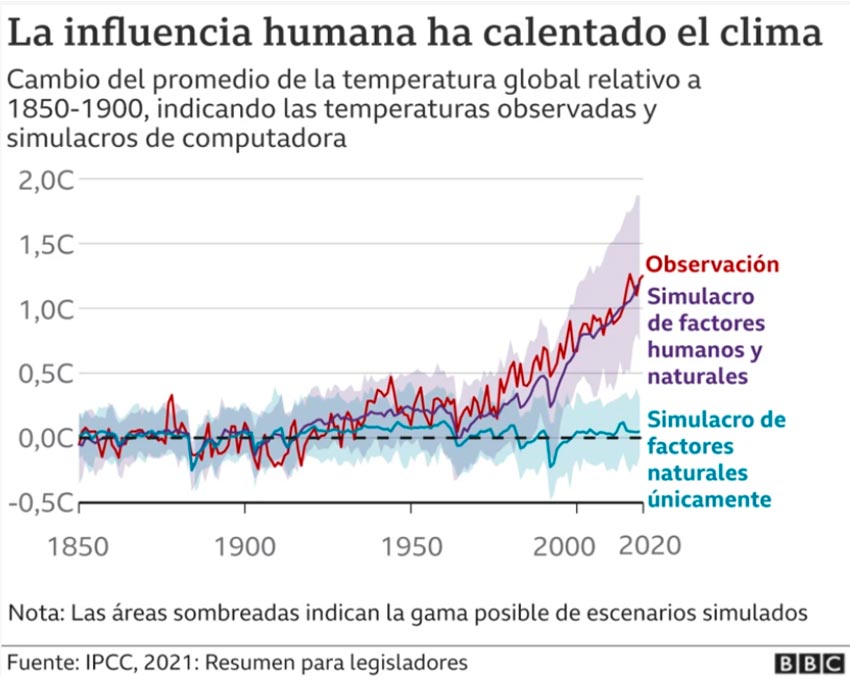
Fig. 1 Human influence has warmed the climate.
Source: IPCC Report 2021
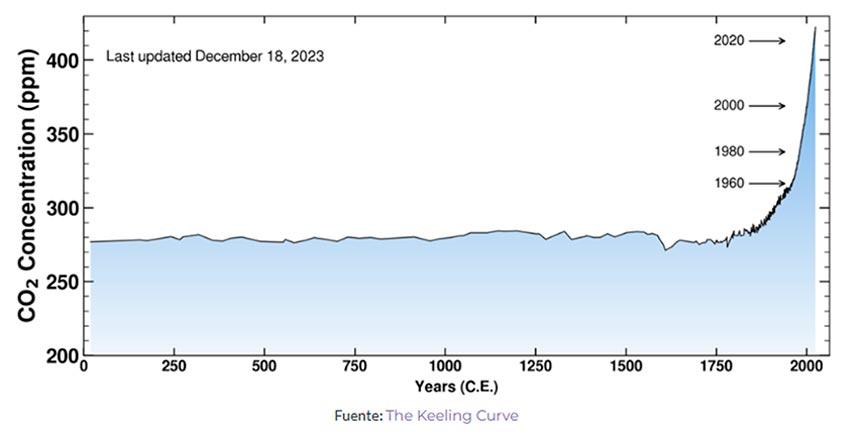
Fig . 2 CO2 concentration. PPM
Source: The Keeling Curve
2024 COP29, Baku . As we write this, the 29th COP is just a few days away.

Event duration :
11-22 November 2024
Location : Baku, Azerbaijan
President : Mukhtar Babayev
Prime Minister : Ali Asadov Population : 10.11 million (2023)
Theme : Investing in a habitable planet for all
Specific objectives of COP29: These will focus largely on finance, as countries are required to set a new global target for climate finance by 2025. A new financing target will be adopted, replacing the current one of $100 billion per year between 2020 and 2025.
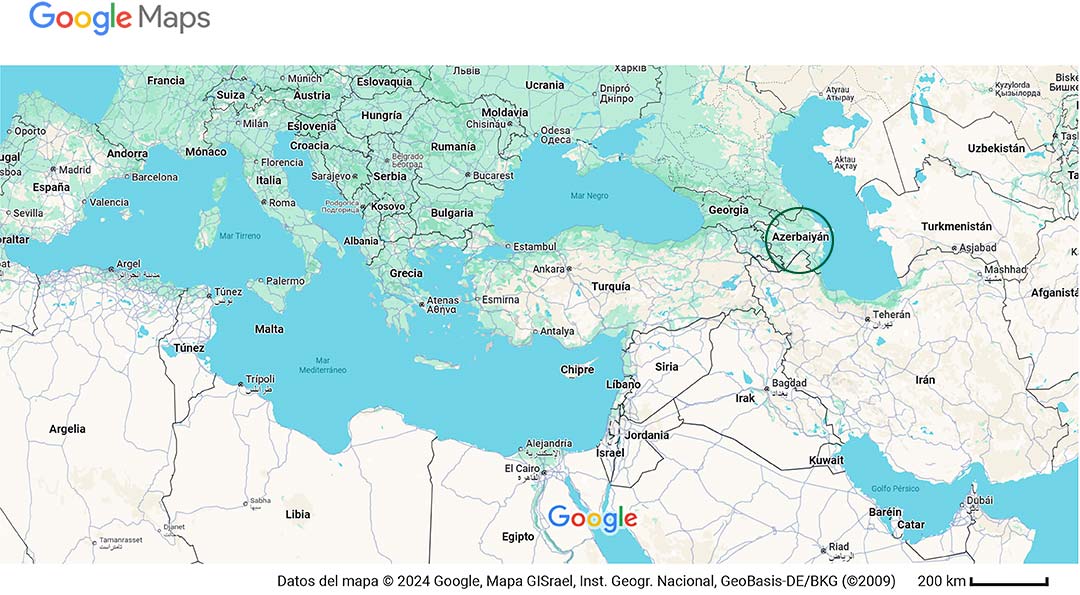
Fig 1. Contextual map of Azerbaijan
Source: Google Maps . Oct. 2024
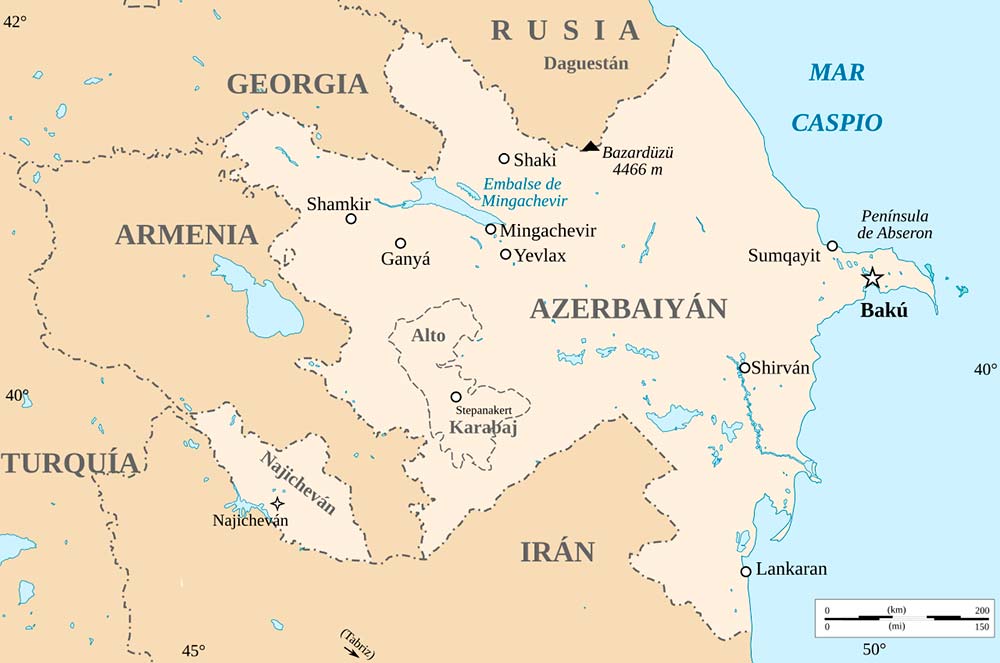
Fig. 2 Map of Azerbaijan
Source: rowanwindwhistler
CC BY-SA 4.0 , Wikimedia Commons
Towards three decades of the COP…
Have the year’s most important climate conferences worked?
Global average temperature between 1850 and 2023
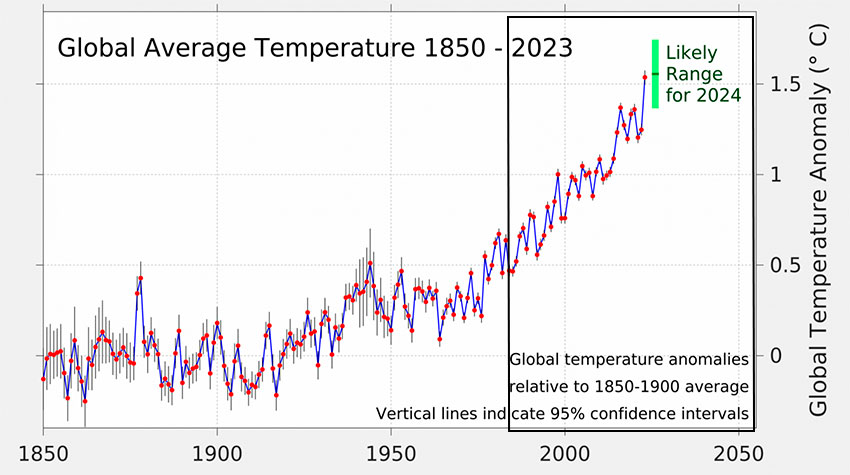
Fig. Global average temperature 1850-2050
Source : Berkeley Earth. Berekeleyearth.org.
Credit: Creative Commons. Attribution- NonCommercial 4.0 International
(CC BY-NC 4.0) Creative Commons BY-NC 4.0
Temperature evolution between 1972 and 2025
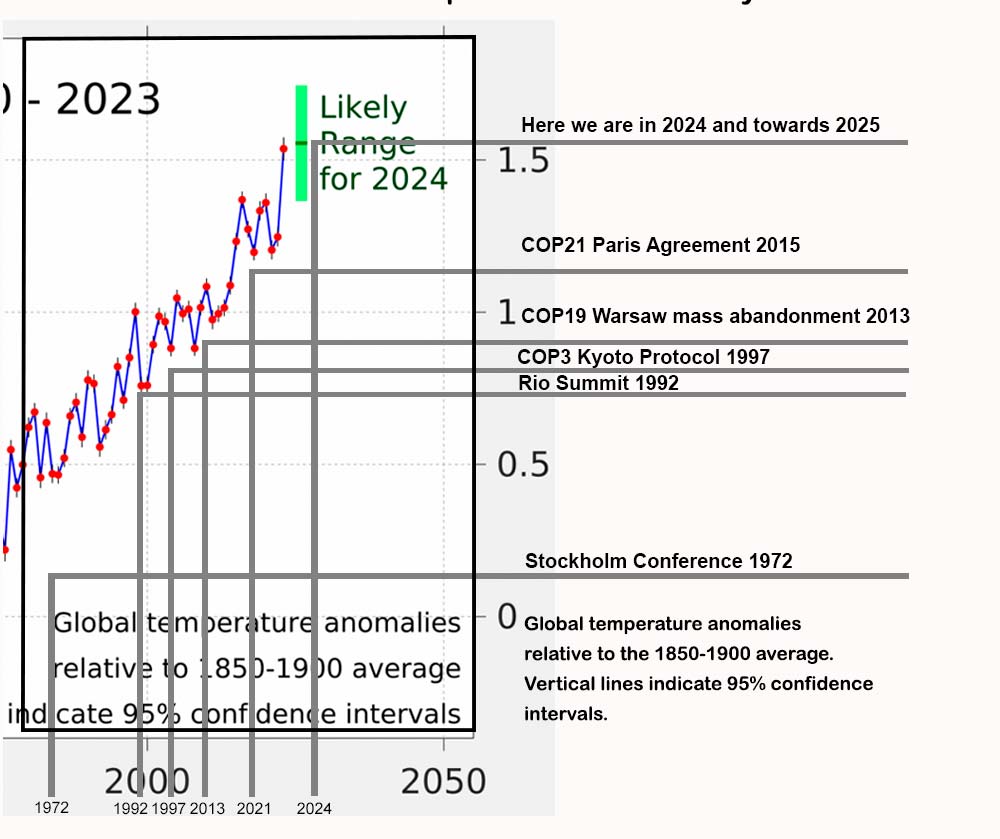
Fig. 6 Infographic Evolution of temperature between 1972 and 2025
Analysis and Production: Sandor A. Gerendas-Kiss/Aíxa Chacín
Original graphic source: Berkeley Earth. Berekeleyearth.org. Details fig. 5
Consequences:
Record hurricanes – Catastrophic floods – Devastating fires – Global droughts – Desertification of the planet – Air pollution.
Conclusion
A Stockholm Conference 1972, a Rio Conference 1992, a COP3 Kyoto Protocol 1997, a COP19 Warsaw with massive abandonment 2013, a COP21 Paris Agreement
“+2.8°C is forecast by the end of the century,” he adds, “Catastrophic!” Antonio Guterres, UN Secretary-General
“New ideas are urgently needed for effective control of the planet’s climate.” SGK-PLANET
©A Brief History of COPs, 2015-2024. SGK-PLANET
©Sandor Alejandro Gerendas-Kiss. Editor in Chief
©Aixa Chacin. Design and Editorial Coordinator
Call to our readers
Starting in 2025, the year that marks three decades of the COPs, we will begin publishing our readers’ comments and short writings on SGK-PLANET, so that they can express their ideas and opinions about the Climate COPs and related topics, under the following rules.
Rules and conditions of this call
- It is mandatory to enter your real name and surname. 2. You must enter your verifiable email address. 3. You must provide your place of residence, from which you are writing. 4. Respect all points of view and opinions. 5. Do not write or discuss political or religious issues. 6. Do not publish other people’s topics, SPAM or chains. 7. Do not publish alarmist or suspicious news WITHOUT CONFIRMING its veracity. 8. Do not give recommendations about diseases or treatments if you are not a health professional. 9. Do not publish violent content, which incites hatred or discrimination of any kind. 10. Do not create controversy. 11. The length of the writing must not exceed 180 words or 1070 characters (with spaces).
SGK-PLANET We reserve the right to reject any writing if we find that any of these rules have been violated. We also reserve the right to take the necessary time to read your writings and approve them before publishing them.

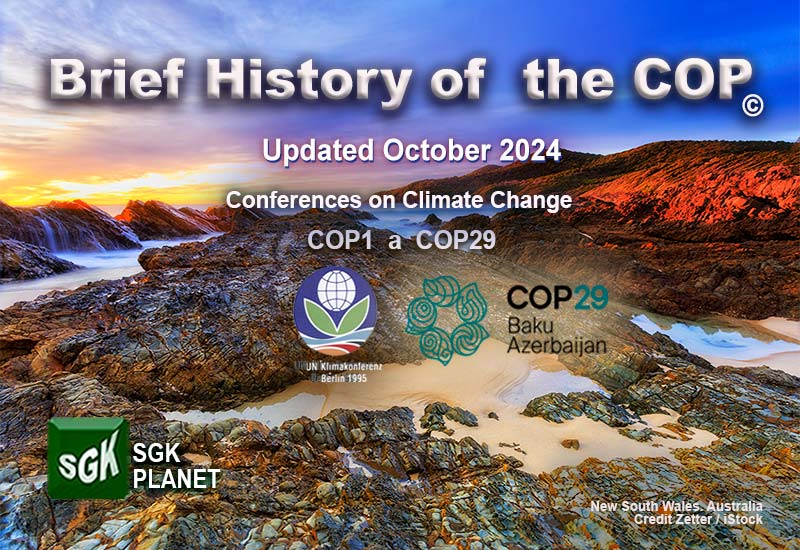





Leave A Comment